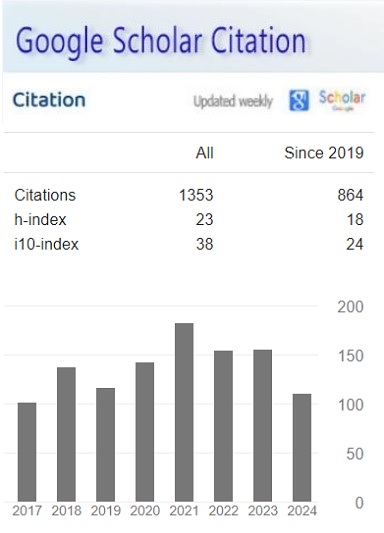Inorganic Effect Pigment-binger System: Pigment Pickup% of Sol-gel Processed Cotton Textile
Keywords:
Abstract
Cotton plain-weaved woven fabric has been treated with an inorganic effect pigment-binder system in water following the sol-gel process. Thickener and dispersing agents have been added to the solution. The fabric was then coated with the prepared solution using the sol-gel process. The pigment-coating was carried on Hochschule Niederrhein, Mönchengladbach, Germany Laboratory Padder with the help of a squeezing roller. After coating, pigment pickup% was measured and compared with each other. In this work, the pickup% of effect pigment-coated cotton textile will be measured and compared with each other.
References
Bras, A., Rozman, T., Gramc, K., Tomšič, B., Gorjanc, M., Kert, M., Simončič, B. (2017). Influence of the nanotechnological process of chemical modifcation on the antimicrobial activity and biodegradability of textile fibres. Tekstilec, 60(1), 14-24 DOI: https://doi.org/10.14502/Tekstilec2017.60.14-24
Brinker, C. J., Hurd, A. J., Frye, G. C., Ward, K. J., & Ashley, C. S. (1990). Sol-gel thin film formation. Journal of Non-Crystalline Solids, 121(1-3), 294–302 DOI: https://doi.org/10.1016/0022-3093(90)90147-E
CHT Germany GmbH, Germany. Web: https://www.cht.com/
Demir, A., Arık, B., Ozdogan, E., & Seventekin, N. (2010). The comparison of the effect of enzyme, peroxide, plasma and chitosan processes on wool fabrics and evaluation for antimicrobial activity. Fibers and Polymers, 11(7), 989–995 DOI: https://doi.org/10.1007/s12221-010-0989-5
Eckart GmbH, Germany. Web: https://www.eckart.net/contact/locationsdistributors/europe/eckart-germany.html
Hribernik, S., Pivec, T., Kurečič, M., Kolar, M., & Stana-Kleinschek, K. (2012). Optimization of the sol–gel-assisted procedure for binding of silver onto modal fibres. In 7th central European conference, 265-271
Hsieh, Y. (2007). Chemical structure and properties of cotton. Cotton Science and Technology, 3-34. DOI: https://doi.org/10.1533/9781845692483.1.3
Klemenčič, D., Tomšič, B., Kovač, F., & Simončič, B. (2012). Antimicrobial cotton fibres prepared by in situ synthesis of AgCl into a silica matrix. Cellulose, 19(5), 1715–1729 DOI: https://doi.org/10.1007/s10570-012-9735-z
Klemenčič, D., Tomšič, B., Kovač, F., Žerjav, M., Simončič, A., & Simončič, B. (2013). Antimicrobial wool, polyester and a wool/polyester blend created by silver particles embedded in a silica matrix. Colloids and Surfaces B: Biointerfaces, 111, 517–522 DOI: https://doi.org/10.1016/j.colsurfb.2013.06.044
Mahltig, B. (2008). Nanosols and textiles. World Scientific, Singapore DOI: https://doi.org/10.1142/6961
Maile, F. J., Pfaff, G., & Reynders, P. (2005). Effect pigments—past, present and future. Progress in Organic Coatings, 54(3), 150–163 DOI: https://doi.org/10.1016/j.porgcoat.2005.07.003
Manda, B. M. K., Worrell, E., & Patel, M. K. (2015). Prospective life cycle assessment of an antibacterial T-shirt and supporting business decisions to create value. Resources, Conservation and Recycling, 103, 47–57 DOI: https://doi.org/10.1016/j.resconrec.2015.07.010
Pal, L., Paul, D. and Fleming, III (2006). The Study of Ink Pigment Dispersion Parameters. The Hilltop Review: 2(1), 61-70
Pfaff, G., Franz, K.-D., Emmert, R., Nitta, K., & Besold, R. (2009). Pigments, Inorganic, 6. Luster Pigments. Ullmann’s Encyclopedia of Industrial Chemistry DOI: https://doi.org/10.1002/14356007.n20_n05
Pivec, T., Perin, Z., Hribernik, S., Maver, T., Kolar, M., Stana-Kleinschek, K. (2012). Binding Silver Nano-Particles onto Viscose Non-Woven Using Different Commercial Sol- Gel Procedures. Materials and technology 46, 75–80
Powell, M. J., Quesada-Cabrera, R., Travis, W. L., & Parkin, I. P. (2015). High-throughput synthesis of core–shell and multi-shelled materials by fluidised bed chemical vapour deposition. Case study: double-shell rutile–anatase particles. Journal of Materials Chemistry A, 3(33), 17241–17247. DOI: https://doi.org/10.1039/C5TA03526K
Rao, B. G., Mukherjee, D., & Reddy, B. M. (2017). Novel approaches for preparation of nanoparticles. Nanostructures for Novel Therapy, 1–36 DOI: https://doi.org/10.1016/B978-0-323-46142-9.00001-3
Rockwood Clay Additives GmbH, Laponite-brochure, Germany. Link: https://www.byk.com/fileadmin/byk/additives/product_groups/rheology/former_rockwood_additives/technical_brochures/BYK_B-RI21_LAPONITE_EN.pdf
Royal Society of Chemistry http://www.rsc.org/publishing/journals/prospect/ontology.asp?id=CMO:0001313&MSID=B101516H (accessed 26 December, 2018)
Sadej, M., & Andrzejewska, E. (2016). Silica/aluminum oxide hybrid as a filler for photocurable composites. Progress in Organic Coatings, 94, 1–8 DOI: https://doi.org/10.1016/j.porgcoat.2016.01.008
Thompson, D. W., & Butterworth, J. T. (1992). The nature of laponite and its aqueous dispersions. Journal of Colloid and Interface Science, 151(1), 236–243 DOI: https://doi.org/10.1016/0021-9797(92)90254-J
Tomšič, B., Simončič, B., Orel, B., Černe, L., Tavčer, P. F., Zorko, M., Kovač, J. (2008). Sol–gel coating of cellulose fibres with antimicrobial and repellent properties. Journal of Sol-Gel Science and Technology, 47(1), 44–57 DOI: https://doi.org/10.1007/s10971-008-1732-1
Tomšič, B., Simončič, B., Orel, B., Žerjav, M., Schroers, H., Simončič, A., & Samardžija, Z. (2009). Antimicrobial activity of AgCl embedded in a silica matrix on cotton fabric. Carbohydrate Polymers, 75(4), 618–626 DOI: https://doi.org/10.1016/j.carbpol.2008.09.013
Wakelyn, P., Bertoniere, N., French, A., Thibodeaux, D., Triplett, B., Rousselle, M., Goynes, Jr., W., Edwards, J., Hunter, L., McAlister, D., Gamble, G. (2006). Cotton Fiber Chemistry and Technology. CRC Press, Boca Raton DOI: https://doi.org/10.1201/9781420015270.ch9
Downloads
Published
How to Cite
Issue
Section
License
Copyright (c) 2020 Asian Journal of Applied Science and Engineering

This work is licensed under a Creative Commons Attribution-NonCommercial 4.0 International License.








